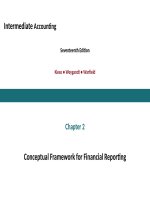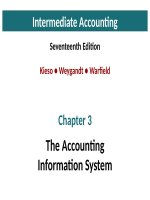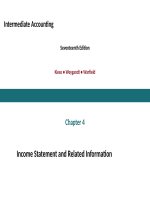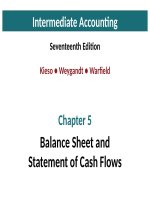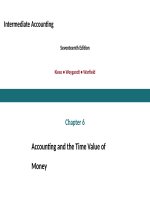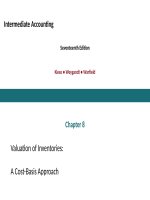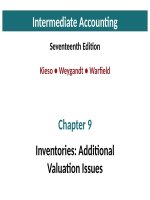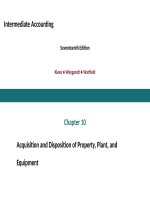Intermediate accounting 17e by kieso ch02
Bạn đang xem bản rút gọn của tài liệu. Xem và tải ngay bản đầy đủ của tài liệu tại đây (531.39 KB, 64 trang )
Intermediate Accounting
Seventeenth Edition
Kieso ● Weygandt ● Warfield
Chapter 2
Conceptual Framework for Financial Reporting
This slide deck contains animations. Please disable animations if they cause issues with your device.
Learning Objectives
After studying this chapter, you should be able to:
1.
Describe the usefulness of a conceptual framework and the objective of financial reporting.
2.
Identify the qualitative characteristics of accounting information and the basic elements of
financial statements.
3.
Review the basic assumptions of accounting.
4.
Explain the application of the basic principles of accounting.
Copyright ©2019 John Wiley & Sons, Inc.
2
Preview of Chapter 2 (1 of 3)
Conceptual Framework for Financial Reporting
Conceptual Framework
•
Need
•
Development
•
Overview
•
Basic Objective
Copyright ©2019 John Wiley & Sons, Inc.
3
Preview of Chapter 2 (2 of 3)
Fundamental Concepts
•
Qualitative characteristics
•
Basic elements
Assumptions
•
Economic entity
•
Going Concern
•
Monetary Unit
•
Periodicity
Copyright ©2019 John Wiley & Sons, Inc.
4
Preview of Chapter 2 (3 of 3)
Measurement, Recognition, and Disclosure Concepts
•
Basic principles of accounting
•
Cost constraint
•
Summary of the structure
Copyright ©2019 John Wiley & Sons, Inc.
5
Learning Objective 1
Describe the Usefulness of a Conceptual Framework and the
Objective of Financial Reporting
Copyright ©2019 John Wiley & Sons, Inc.
6
Conceptual Framework
The Need for a Conceptual Framework
LO 1
•
Enables the FASB to issue more useful and consistent pronouncements over time
•
To solve new and emerging practical problems
Copyright ©2019 John Wiley & Sons, Inc.
7
Development of a Conceptual Framework
The FASB has issued seven Statements of Financial Accounting Concepts (SFAC) for business enterprises.
SFAC No. 1
Objectives of Financial Reporting (superseded by S FAC No. 8)
SFAC No. 2
Qualitative Characteristics of Accounting Information. (superseded by SFAC No. 8)
SFAC No. 3
Elements of Financial Statements. (superseded by S FAC No. 6)
SFAC No. 5
Recognition and Measurement in Financial Statements.
SFAC No. 6
Elements of Financial Statements (replaces S FAC No. 3).
SFAC No. 7
Using Cash Flow Information and Present Value in Accounting Measurements.
SFAC No. 8
The Objective of General Purpose Financial Reporting and Qualitative Characteristics of Useful Financial Information (replaces S FAC
Nos. 1 and 2)
LO 1
Copyright ©2019 John Wiley & Sons, Inc.
8
Overview of the Conceptual Framework
LO 1
•
First Level = Objective of Financial Reporting
•
Second Level = Qualitative Characteristics and Elements
•
Third Level = Recognition, Measurement, and Disclosure Concepts
Copyright ©2019 John Wiley & Sons, Inc.
9
Overview of the
Conceptual
Framework chart
LO 1
Copyright ©2019 John Wiley & Sons, Inc.
10
Conceptual Framework
Basic Objective
To provide financial information about the reporting entity that is useful to present and potential
equity investors, lenders, and other creditors in making decisions about providing resources to the
entity.
LO 1
Copyright ©2019 John Wiley & Sons, Inc.
11
Conceptual Framework
Review Question
What are the Statements of Financial Accounting Concepts intended to establish?
a.
Generally accepted accounting principles in financial reporting by business enterprises.
b.
The meaning of “Present fairly in accordance with generally accepted accounting principles.”
c.
The objectives and concepts for use in developing standards of financial accounting and
reporting.
d.
LO 1
The hierarchy of sources of generally accepted accounting principles.
Copyright ©2019 John Wiley & Sons, Inc.
12
Conceptual Framework
Review Question Answer
What are the Statements of Financial Accounting Concepts intended to establish?
a.
Generally accepted accounting principles in financial reporting by business enterprises.
b.
The meaning of “Present fairly in accordance with generally accepted accounting principles.”
c.
The objectives and concepts for use in developing standards of financial accounting and
reporting.
d.
LO 1
The hierarchy of sources of generally accepted accounting principles.
Copyright ©2019 John Wiley & Sons, Inc.
13
Learning Objective 2
Identify the Qualitative Characteristics of Accounting Information
and the Basic Elements of Financial Statements
Copyright ©2019 John Wiley & Sons, Inc.
14
Fundamental Concepts
Qualitative Characteristics
of Accounting Information
“The FASB identified the qualitative characteristics of accounting information that distinguish better
(more useful) information from inferior (less useful) information for decision-making purposes.”
LO 2
Copyright ©2019 John Wiley & Sons, Inc.
15
Qualitative Characteristics
LO 2
Copyright ©2019 John Wiley & Sons, Inc.
16
Fundamental Quality
—Relevance
(1 of 5)
LO 2
Copyright ©2019 John Wiley & Sons, Inc.
17
Fundamental Quality—Relevance (2 of 5)
To have relevance, accounting information must be capable of making a difference in a decision.
LO 2
Copyright ©2019 John Wiley & Sons, Inc.
18
Fundamental Quality—Relevance (3 of 5)
Financial information has predictive value if it has value as an input to predictive processes used by investors to
form their own expectations about the future.
LO 2
Copyright ©2019 John Wiley & Sons, Inc.
19
Fundamental Quality—Relevance (4 of 5)
Relevant information also helps users confirm or correct prior expectations.
LO 2
Copyright ©2019 John Wiley & Sons, Inc.
20
Fundamental Quality—Relevance (5 of 5)
Information is material if omitting it or misstating it could influence decisions that users make on the basis of the
reported financial information.
LO 2
Copyright ©2019 John Wiley & Sons, Inc.
21
Fundamental Quality—
Faithful Representation
(1 of 5)
LO 2
Copyright ©2019 John Wiley & Sons, Inc.
22
Faithful Representation (2 of 5)
Faithful representation means that the numbers and descriptions match what really existed or happened.
LO 2
Copyright ©2019 John Wiley & Sons, Inc.
23
Faithful Representation (3 of 5)
Completeness means that all the information that is necessary for faithful representation is provided.
LO 2
Copyright ©2019 John Wiley & Sons, Inc.
24
Faithful Representation (4 of 5)
Neutrality means that a company cannot select information to favor one set of interested parties over another.
LO 2
Copyright ©2019 John Wiley & Sons, Inc.
25
